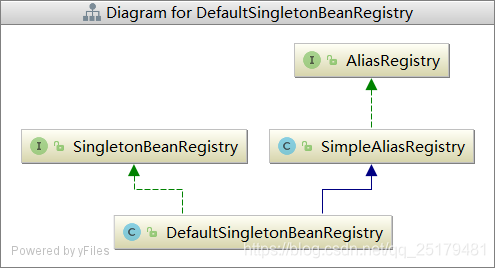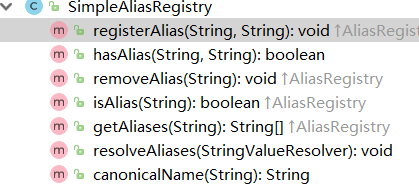首先看接口的关系:
AliasRegistry 即Bean对应的别名,直接看其实现类的关系:
可以看到是用一个并发Map来存储对应的关系:
而关于其的方法,可以看主要的两个方法,即RegisterAlias与getAlias:
首先看RegisterAlias:
public void registerAlias(String name, String alias) {
Assert.hasText(name, "'name' must not be empty");
Assert.hasText(alias, "'alias' must not be empty");
//如果alias对于beanName则直接删除原来的,也就是如果原来有存b->a,现在存b->b,
则直接删除a->b,并且a->a也保存
if (alias.equals(name)) {
this.aliasMap.remove(alias);
}
else {
String registeredName = this.aliasMap.get(alias);
if (registeredName != null) {
if (registeredName.equals(name)) {
// An existing alias - no need to re-register
return;
}
if (!allowAliasOverriding()) {
throw new IllegalStateException("Cannot register alias '" + alias + "' for name '" +
name + "': It is already registered for name '" + registeredName + "'.");
}
}
checkForAliasCircle(name, alias);
this.aliasMap.put(alias, name);
}
}然后上面checkForAliasCircle,即循环检查,
这里应该从getAliases说起了:
public String[] getAliases(String name) {
List<String> result = new ArrayList<>();
synchronized (this.aliasMap) {
retrieveAliases(name, result);
}
return StringUtils.toStringArray(result);
}
这里又有一个自循环:
private void retrieveAliases(String name, List<String> result) {
this.aliasMap.forEach((alias, registeredName) -> {
if (registeredName.equals(name)) {
result.add(alias);
retrieveAliases(alias, result);
}
});
}即首先通过BeanName获取其别名,再以别名Alias为BeanName获取其别名,()如下:
由此可见,其需要进行循环检查,不然就会进入死循环:
之后再看接口SingletonBeanRegistry:
之后即类DefaultSingletonBeanRegistry:
关键是对这些全局变量的操作:
我们结合具体代码来说明这些全局变量:
首先:registerSingleton(String beanName, Object singletonObject);
public void registerSingleton(String beanName, Object singletonObject) throws IllegalStateException {
Assert.notNull(beanName, "Bean name must not be null");
Assert.notNull(singletonObject, "Singleton object must not be null");
synchronized (this.singletonObjects) {
Object oldObject = this.singletonObjects.get(beanName);
if (oldObject != null) {
throw new IllegalStateException("Could not register object [" + singletonObject +
"] under bean name '" + beanName + "': there is already object [" + oldObject + "] bound");
}
addSingleton(beanName, singletonObject);
}
}
进入addSingleton方法:
protected void addSingleton(String beanName, Object singletonObject) {
synchronized (this.singletonObjects) {
this.singletonObjects.put(beanName, singletonObject);
this.singletonFactories.remove(beanName);
this.earlySingletonObjects.remove(beanName);
this.registeredSingletons.add(beanName);
}
}
这里涉及到四个全局变量:通过代码可以看到在这里是将一个单例对象singletonObject条件到singletonObjects、registeredSingletons里,这个registeredSingletons通过名字我们可以知道,其就是已经注册过的Bean对象了。但是在这里你们是否有发现一个问题,为什么要用一个registeredSingletons去标识已注册Bean对象,也可以用singletonObjects啊?这里我们可以看有哪些地方有用到这个registeredSingletons(将bean对象添加到singletonObjects只有这里有添加),其中一处使用的地方就是我们刚才说的,还有一处就是:
protected void addSingletonFactory(String beanName, ObjectFactory<?> singletonFactory) {
Assert.notNull(singletonFactory, "Singleton factory must not be null");
synchronized (this.singletonObjects) {
if (!this.singletonObjects.containsKey(beanName)) {
this.singletonFactories.put(beanName, singletonFactory);
this.earlySingletonObjects.remove(beanName);
this.registeredSingletons.add(beanName);
}
}
}
这里我们可以看到是将一个singletonFactories添加到singletonFactories中,同时添加到registeredSingletons中,这里我们应该
可以知道表示已注册的Bean应该有两条线去标识它,即添加singletonObject与singletonFactory时,但其实我们正常创建一个bean它是先添加到singletonFactories里面去的,同时添加到registeredSingletons里,之后会在addSingleton(String beanName, Object singletonObject)再添加一次到registeredSingletons里,不过这次会失败:
先调用addSingletonFactory方法添加,
之后会再调用一次addSingleton
那spring为什么会这样多此一举的设计呢?
public void registerSingleton(String beanName, Object singletonObject) throws IllegalStateException {
Assert.notNull(beanName, "Bean name must not be null");
Assert.notNull(singletonObject, "Singleton object must not be null");
synchronized (this.singletonObjects) {
Object oldObject = this.singletonObjects.get(beanName);
if (oldObject != null) {
throw new IllegalStateException("Could not register object [" + singletonObject +
"] under bean name '" + beanName + "': there is already object [" + oldObject + "] bound");
}
addSingleton(beanName, singletonObject);
}
}
我们可以点这个方法看它有哪些方法调用它,我们发现在这个直接添加singletonObject会将spring自己的类添加进去,如:
所以可以知道,registeredSingletons与singletonObjects区别,一个是这个Spring容器的所有单例Bena,而另一个是我们注入的Bean。
之后我们将目光用到另一个全局变量上:earlySingletonObjects,关于这个我们需要直接跳到DefaultSingletonBeanRegistry的父类AbstractAutowireCapableBeanFactory,看bean实例的创建
doCreateBean(final String beanName, final RootBeanDefinition mbd, final @Nullable Object[] args){方法中有局部变量earlySingletonExposure:
boolean earlySingletonExposure = (mbd.isSingleton() && this.allowCircularReferences &&
isSingletonCurrentlyInCreation(beanName));
可以看到它的值是有三个决定的,即是不是单例,允不允许循环调用、还有是不是这个bean正在创建中,可以看我的这篇博客:https://blog.csdn.net/qq_25179481/article/details/89241914;
这个isSingletonCurrentlyInCreation是DefaultSingletonBeanRegistry的方法:
public boolean isSingletonCurrentlyInCreation(String beanName) {
return this.singletonsCurrentlyInCreation.contains(beanName);
}
这里可以看到在方法
getSingleton(String beanName, ObjectFactory<?> singletonFactory)中是先将:
创建bean对象时先将其加入到:
beforeSingletonCreation(beanName);中
再调用singletonObject = singletonFactory.getObject();
singletonFactory去创建,在这里singletonFactory.getObject();可能就有循环调用了,因为需要完成singletonFactory.getObject();才会调用下一步:
finally {
if (recordSuppressedExceptions) {
this.suppressedExceptions = null;
}
afterSingletonCreation(beanName);
}
将其从全局变量singletonsCurrentlyInCreation清掉表明完成创建:
protected void afterSingletonCreation(String beanName) {
if (!this.inCreationCheckExclusions.contains(beanName) && !this.singletonsCurrentlyInCreation.remove(beanName)) {
throw new IllegalStateException("Singleton '" + beanName + "' isn't currently in creation");
}
}
所以在变量:boolean earlySingletonExposure,如果有循环调用:
boolean earlySingletonExposure = (mbd.isSingleton() && this.allowCircularReferences &&
isSingletonCurrentlyInCreation(beanName));
if (earlySingletonExposure) {
if (logger.isDebugEnabled()) {
logger.debug("Eagerly caching bean '" + beanName +
"' to allow for resolving potential circular references");
}
addSingletonFactory(beanName, () -> getEarlyBeanReference(beanName, mbd, bean));
}
需要提前将这个ObjectFactory
初始化的还没有进行任何赋值的空对象暴露到:
protected void addSingletonFactory(String beanName, ObjectFactory<?> singletonFactory) {
Assert.notNull(singletonFactory, "Singleton factory must not be null");
synchronized (this.singletonObjects) {
if (!this.singletonObjects.containsKey(beanName)) {
this.singletonFactories.put(beanName, singletonFactory);
this.earlySingletonObjects.remove(beanName);
this.registeredSingletons.add(beanName);
}
}
}
同时我们可以看到在 addSingletonFactory(beanName, () -> getEarlyBeanReference(beanName, mbd, bean));后就会:
if (earlySingletonExposure) { if (logger.isDebugEnabled()) { logger.debug("Eagerly caching bean '" + beanName + "' to allow for resolving potential circular references"); } addSingletonFactory(beanName, () -> getEarlyBeanReference(beanName, mbd, bean)); } // Initialize the bean instance. Object exposedObject = bean; try { populateBean(beanName, mbd, instanceWrapper); exposedObject = initializeBean(beanName, exposedObject, mbd); } catch (Throwable ex) { if (ex instanceof BeanCreationException && beanName.equals(((BeanCreationException) ex).getBeanName())) { throw (BeanCreationException) ex; } else { throw new BeanCreationException( mbd.getResourceDescription(), beanName, "Initialization of bean failed", ex); } } if (earlySingletonExposure) { Object earlySingletonReference = getSingleton(beanName, false);
通过populateBean(beanName, mbd, instanceWrapper);去给循环的Bean赋值,然后就会来到最开始的AbstractBeanFactory
:
@Override
public Object getBean(String name) throws BeansException {
return doGetBean(name, null, null, false);
}
protected <T> T doGetBean(final String name, @Nullable final Class<T> requiredType,
@Nullable final Object[] args, boolean typeCheckOnly) throws BeansException {
final String beanName = transformedBeanName(name);
Object bean;
// Eagerly check singleton cache for manually registered singletons.
Object sharedInstance = getSingleton(beanName);
....................
在这里就会将前面的addSingletonFactory(beanName, () -> getEarlyBeanReference(beanName, mbd, bean));
的ObjectFactory的内容创建暴露到earlySingletonObjects:
synchronized (this.singletonObjects) {
singletonObject = this.earlySingletonObjects.get(beanName);
if (singletonObject == null && allowEarlyReference) {
ObjectFactory<?> singletonFactory = this.singletonFactories.get(beanName);
if (singletonFactory != null) {
singletonObject = singletonFactory.getObject();
this.earlySingletonObjects.put(beanName, singletonObject);
this.singletonFactories.remove(beanName);
}
}
}
以上这些操作,其实都是AbstractBeanFactory的:
public Object getBean(String name) throws BeansException {
return doGetBean(name, null, null, false);
}
然后在doGetBean里的:
if (mbd.isSingleton()) {
sharedInstance = getSingleton(beanName, () -> {
try {
return createBean(beanName, mbd, args);
}
catch (BeansException ex) {
// Explicitly remove instance from singleton cache: It might have been put there
// eagerly by the creation process, to allow for circular reference resolution.
// Also remove any beans that received a temporary reference to the bean.
destroySingleton(beanName);
throw ex;
}
});
bean = getObjectForBeanInstance(sharedInstance, name, beanName, mbd);
};
这个getSingleton(beanName, () -> {其实就是DefaultSingletonBeanRegistry的
getSingleton(String beanName, ObjectFactory<?> singletonFactory) ;
而return createBean(beanName, mbd, args);,就是singletonObject = singletonFactory.getObject();获取bean并赋值的过程,
现在赋值完成后,就通过addSingleton(beanName, singletonObject);,将其暴露到singletonObjects里,这个时候就真正完成了一个Bean的创建于赋值了。
if (newSingleton) {
addSingleton(beanName, singletonObject);
}
DefaultSingletonBeanRegistry的getSingleton(String beanName, ObjectFactory<?> singletonFactory)方法摘要:
beforeSingletonCreation(beanName);
boolean newSingleton = false;
boolean recordSuppressedExceptions = (this.suppressedExceptions == null);
if (recordSuppressedExceptions) {
this.suppressedExceptions = new LinkedHashSet<>();
}
try {
singletonObject = singletonFactory.getObject();
newSingleton = true;
}
catch (IllegalStateException ex) {
// Has the singleton object implicitly appeared in the meantime ->
// if yes, proceed with it since the exception indicates that state.
singletonObject = this.singletonObjects.get(beanName);
if (singletonObject == null) {
throw ex;
}
}
catch (BeanCreationException ex) {
if (recordSuppressedExceptions) {
for (Exception suppressedException : this.suppressedExceptions) {
ex.addRelatedCause(suppressedException);
}
}
throw ex;
}
finally {
if (recordSuppressedExceptions) {
this.suppressedExceptions = null;
}
afterSingletonCreation(beanName);
}
if (newSingleton) {
addSingleton(beanName, singletonObject);
}
自此DefaultSingletonBeanRegistry的几个关键的全局变量,就梳理完毕,而其他的关于DependentBean的全局变量,到时候在写下这篇的下部分。个人感觉,对于spring的总流程来说,这个DependentBean的流程,应该没怎么复杂,也不算是构建spring很核心部分的内容,所以不会在这一篇的后面,之后有时间,通过测试demo简单说明一下吧。











